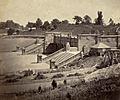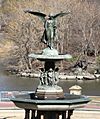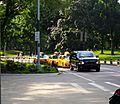Central Park facts for kids
Quick facts for kids Central Park |
|
|---|---|
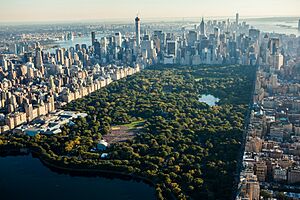
Aerial view of southern Central Park (September 2014)
|
|
| Type | Urban park |
| Location | Manhattan, New York City, New York, U.S. |
| Area | 843 acres (341 ha; 1.317 sq mi; 3.41 km2) |
| Created | 1857–1876 |
| Owned by | NYC Parks |
| Operated by | Central Park Conservancy |
| Visitors | about 42 million annually |
| Open | 6:00 a.m. to 1:00 a.m. |
| Public transit access | Subway and bus; see "Public transport" |
| Architect | Frederick Law Olmsted (1822–1903), Calvert Vaux (1824–1895) |
| NRHP reference No. | 66000538 |
| Significant dates | |
| Added to NRHP | October 15, 1966 |
| Designated NHL | May 23, 1963 |
Central Park is a huge urban park in Manhattan, New York City. It's located between the Upper West Side and Upper East Side neighborhoods. It was the first park in the United States to be designed with a specific landscape plan.
Central Park is the sixth-largest park in New York City. It covers about 843 acres (3.4 square kilometers). It's also the most visited city park in the U.S. Around 42 million people visit it every year.
People first suggested building a large park in Manhattan in the 1840s. In 1853, a 778-acre area was approved for the park. In 1857, two landscape architects, Frederick Law Olmsted and Calvert Vaux, won a contest to design the park. Their plan was called the "Greensward Plan."
Construction started in 1857. Land, including a community called Seneca Village, was bought by the city and cleared. The first parts of the park opened in late 1858. More land was bought in 1859, and the park was finished in 1876.
After some tough times in the early 1900s, Robert Moses, a New York City parks commissioner, began cleaning up Central Park in the 1930s. Later, in 1980, the Central Park Conservancy was created. This group helped fix up many parts of the park starting in the 1980s.
Some of the park's main attractions include beautiful areas like the Ramble and Lake and Sheep Meadow. There are also fun spots like Wollman Rink (for ice skating) and the Central Park Zoo. You can also find formal areas like the Central Park Mall and Bethesda Terrace. The park is home to many different kinds of plants and animals.
People can enjoy activities like horse carriage rides, bike tours, sports, and concerts. There are also special events like "Shakespeare in the Park." Central Park has many roads and paths, and you can easily get there by subway or bus.
Central Park is a famous example for other city parks around the world. Because of its size and importance, it was named a National Historic Landmark in 1963. It also became a New York City scenic landmark in 1974. The park is owned by the New York City Department of Parks and Recreation. However, the Central Park Conservancy has managed it since 1998. This non-profit group raises money for the park's yearly costs and takes care of its daily needs.
Contents
How Big is Central Park?
Central Park is 2.5 miles (4 kilometers) long. It stretches from 59th Street (Central Park South) to 110th Street (Central Park North). It is 0.5 miles (0.8 kilometers) wide. This is the distance between Fifth Avenue and Central Park West.
The park is similar in size to other famous parks. These include San Francisco's Golden Gate Park and Vancouver's Stanley Park. Central Park is bigger than small countries like Monaco and Vatican City. However, some other parks in New York City are even larger.
The park is surrounded by important areas of New York City. These include Harlem to the north and the Upper West Side and Upper East Side. The streets around the park have special names. For example, 110th Street becomes Central Park North.
History of Central Park
In 1855, New York City was growing very fast. It had four times as many people as it did in 1821. The city needed more green spaces. So, a large park was planned for Upper Manhattan.
In 1853, the New York state government set aside about 700 acres for the park. This land was between 59th and 106th Streets. The land itself cost over US$5 million.
The park first opened in 1857. In 1858, Frederick Law Olmsted and Calvert Vaux won a contest to design the park. Their plan was called the "Greensward Plan." They wanted to make the park beautiful and useful for everyone.
Construction started in 1858 and finished in 1873. A lot of work went into building the park. Rocks, soil, and many plants were brought in. People who lived on the land chosen for the park had to move. Later, the park was made even larger.
By the 1930s, the park needed a lot of care. Robert Moses, a city official, led an effort to clean it up and make improvements. But by the 1960s, the park faced problems again. So, in the 1980s and 1990s, the Central Park Conservancy was formed. This group worked hard to clean and improve the park.
Central Park was recognized as a National Historic Landmark in 1963. This means it is a very important place in American history.
Who Takes Care of Central Park?
The Central Park Conservancy is the group that manages Central Park. They have an agreement with the city government to do this. A large part of the park's yearly budget comes from the Conservancy. They also provide most of the staff who maintain the park.
The Conservancy staff takes care of many things in the park.
- They look after 250 acres of lawns.
- They care for 21,500 trees.
- They maintain 150 acres of lakes and streams.
- They also manage 130 acres of woodlands.
Every year, they plant thousands of bulbs, shrubs, flowers, and trees. They make sure that 9,000 benches, 26 ballfields, and 21 playgrounds are clean and safe. They also care for 55 sculptures and monuments. Plus, they look after 36 bridges. Conservancy teams remove graffiti and collect over 2,000 tons of trash each year!
The Conservancy has had several leaders over the years. Elizabeth Barlow Rogers helped create the group in 1978. Douglas Blonsky, who used to oversee construction for the park, became president in 2003.
Visitors to Central Park
Central Park is the most visited urban park in the United States. It is also one of the most popular tourist spots in the world. In 2016, it had 42 million visits.
A report from 2011 found that about 8 to 9 million different people visited the park. These people made a total of 37 to 38 million visits. In 2009, there were 25 million visits. In 1973, there were 12.3 million visits.
Not all visitors are tourists. In 2009, about one-fifth of the 25 million park visitors were tourists.
Animals and Plants in Central Park
Central Park has a wide variety of living things. This is called being biologically diverse. A study in 2013 found 571 different species in the park. This included 173 species that were not known to live there before.
Plants in the Park
In 2011, a survey showed that Central Park had over 20,000 trees. This was a decrease from 26,000 trees in 1993. Most of the trees are native to New York City. But there are also some groups of trees that are not from the area.
Almost all the trees, shrubs, and plants in Central Park were planted by people. Over four million plants from about 1,500 different types were brought into the park. The Central Park Conservancy now takes care of the park's plants. Gardeners work in different "zones" to keep everything healthy.
Central Park has ten "great tree" groups that are special. These include four American elms and one group of them. There are also 600 pine trees in the Arthur Ross Pinetum. You can find a black tupelo tree in the Ramble. There are 35 Yoshino cherry trees near the Onassis Reservoir. One of the park's oldest London plane trees is at 96th Street. The American elms in Central Park are important. They are protected from a disease that has harmed elms in other areas.
Animals in the Park
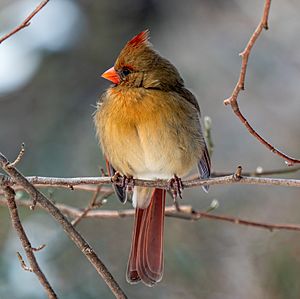
Central Park is a stop for many birds during their spring and fall travels. Over 300 different kinds of birds have been seen in the park. About 200 species are spotted every season.
Some famous birds include a red-tailed hawk named Pale Male. He lived on an apartment building overlooking the park. A colorful mandarin duck nicknamed Mandarin Patinkin became famous in 2018. An Eurasian eagle-owl named Flaco also gained attention in 2023 after escaping the Central Park Zoo.
Central Park has about ten types of mammals. You might see bats at night. Raccoons are common, so the Parks Department warns about rabies. Eastern gray squirrels, eastern chipmunks, and Virginia opossums also live in the park. A survey in 2019 found 2,373 Eastern Gray squirrels in Central Park.
There are 223 types of invertebrates (animals without backbones) in Central Park. One tiny centipede species, Nannarrup hoffmani, was found there in 2002. It's one of the smallest centipedes in the world.
Turtles, fish, and frogs live in Central Park. There are five kinds of turtles. Most of them live in Turtle Pond. Many of these turtles used to be pets that were set free in the park. Different kinds of freshwater fish live in the park's waters. You can fish in the Lake, Pond, and Harlem Meer, but you must release the fish. The park is also home to two types of frogs: the American bullfrog and the green frog.
Central Park in Movies and Books
Central Park has appeared in thousands of books, movies, and TV shows. It's a very famous location! For example, in the U.S. TV show Friends, the coffee shop where the characters hung out was called "Central Perk." This was a fun play on words.
Images for kids
-
Map of the former Seneca Village from Viele's survey for Central Park
-
Bethesda Terrace and Fountain under construction in 1862
-
Belvedere Castle, completed 1869
-
Angel of the Waters (1873) in Bethesda Fountain
-
Cleopatra's Needle, the park's oldest man-made structure
-
Entrance to the Fifth Avenue–59th Street subway station just outside Central Park
See also
 In Spanish: Central Park para niños
In Spanish: Central Park para niños







